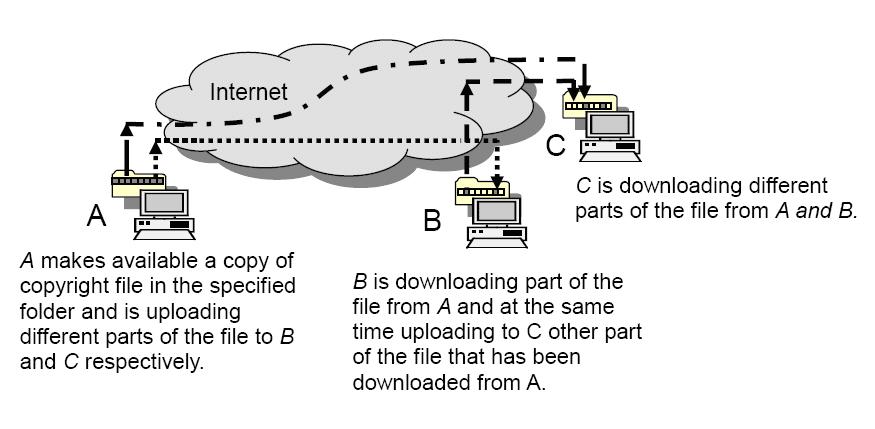- ITSC User Satisfaction and Needs Survey 2021
- Closing of User Area on 26 Mar 2021 (2:00PM – 6:00PM)
- Phishing Alert: Follow Up Email Immediately
- SPSS and AMOS License Server Maintenance for Application Upgrade on 25 Apr
- Phishing Alert: Team Meeting (March)
Risks in Peer-to-peer File Sharing
Sharing files using peer-to-peer (P2P) software is efficient. But if you misuse P2P software, you expose yourself to the following risks:
- Exposing your hard disk to others
- Contracting computer viruses
- Infringing copyright
- Violating CUHK Information Technology Services Centre (ITSC) Acceptable Use Policies
- Slowing down the entire campus network
Among these risks, the consequence of infringing copyright can be the most serious. On one hand, the act of unauthorized uploading of a copyright works for others to download may attract civil or even criminal sanctions. On the other hand, unauthorized downloading of copyright works entails civil liability. If you are not sure about the copyright ownership of the files, you should not perform any uploading or downloading of these files.
Peer-to-peer (P2P) file sharing is the direct transfer of files from one computer to another without going through a server. When using P2P software, it is not necessary for users to upload files that they want to share onto a server. Instead, what they need to do is simply to store files in a specified folder in their computers, and then connect the folder to the Internet through the use of P2P software. The files are then available for other online users who have installed the same P2P software to download. In this way, sharing/downloading of files can be done without the intervention of a centralised server as in the client/server configuration.
Besides, P2P software also allows its users to contribute their computer power and available bandwidth to facilitate file distribution. In other words, the greater the number of people participating in the file sharing activities, the more efficient the downloading process would be.
The commonly used peer-to-peer file sharing software programs are BitTorrent, eDonkey, emule, KaZaA, WinMX, etc.
The process of P2P file sharing can be illustrated by the following diagram:
- Exposing Your Hard Disk to Others
Usually, many peer-to-peer file sharing programs do not employ good security or access control. If users are not familiar with the programs or mis-configure the settings, it will be dangerous for all the contents stored in users’ hard disk to be exposed to other users. - Contracting Computer Viruses
Besides, the computers of P2P software users can easily contract computer viruses especially when the file downloaded is from an unknown source. Moreover, these P2P programs may also contain viruses and worms, which prevent users’ computers from functioning properly. - Infringing Copyright
Many copyright law infringing copies of entertainment files e.g. MP3 music files, VCD video files and etc. and software are often shared by P2P software.
The act of unauthorized uploading of a copyright works for others to download may attract civil or even criminal sanctions. Unauthorized downloading of copyright works entails civil liability. (Reference 5: Copyright Ordinance – Cap. 528) - Violating CUHK Information Technology Services Centre (ITSC) Acceptable Use Policies
Copyright infringement is a serious infraction of ITSC acceptable user policies. Repeated offence will be referred to the College’s Disciplinary Committee for further action without further notice. (Reference 4) - Slowing Down Entire Campus Network
Last but not least, if you host a large amount of files for other people to download through P2P software via the campus network, the network traffic thus created can slow down the entire campus network.
You may have heard of a lawsuit case in Hong Kong in which a citizen was convicted of copyright infringement for his use of BitTorrent in putting copyrighted movies onto the network, and this has been a world news. For more details, please visit:
- “Copyright Protection in the Digital Environment”. https://www.ipd.gov.hk/eng/intellectual_property/copyright/digital_environment.htm
- Intellectual Property Department, the Government of the Hong Kong Special Administrative Region https://www.ipd.gov.hk/eng/home.htm
- “Peer-to-peer”. Wikipedia, the Free Encyclopedia. Wikimedia Foundation, Inc. http://en.wikipedia.org/w/index.php?title=Peer-to-peer&oldid=114558516
- Computer Network – Policies & Guidelines on Access and Usage:
https://www.itsc.cuhk.edu.hk/it-policies/net-guide-use - Copyright Ordinance (Cap. 528) Under the Copyright Ordinance (Cap. 528), any person who makes available a copy of a copyright work to the public on the Internet, without the authorisation of the concerned copyright owner, may attract civil liability. In addition, any person who knowingly distributes an infringing copy of a copyright work either (i) in a business context (e.g. for financial gain), or (ii) to the extent that prejudicially affects the copyright owner in a non-business context (e.g. making available a copyright work free of charge to the extent that the copyright owner can no longer exploit his economic rights to the work), may attract civil and criminal liability. The maximum penalty upon criminal conviction is a fine at level 5 (i.e., currently HK $50,000) in respect of each infringing copy and imprisonment for four years. Furthermore, making a copy of a copyright work without the authorisation of the copyright owner is a civil infringement under the Copyright Ordinance. Copying of a work includes storing the work in any medium by electronic means. As the act of downloading a copyright work involves making a copy of the work at the downloader’s computer, this act may incur civil liability.

